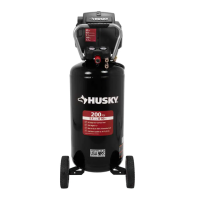
Do you have a question about the Husky C271H and is the answer not in the manual?
| Brand | Husky |
|---|---|
| Model | C271H |
| Category | Air Compressor |
| Language | English |
Guidelines for maintaining a safe work area, including lighting and clearance.
Instructions and warnings for safely lifting, tilting, and transporting the air compressor.
Guidance on selecting and using appropriate extension cords for safe operation.
Proper procedures for connecting the air compressor to a power source.
Essential steps and warnings for properly grounding the air compressor.
Details on what is covered by the manufacturer's warranty.
Exclusions and limitations of the product warranty.
Technical specifications of the 27-gallon portable air compressor.
Recommended operating duty cycle for prolonging compressor life.
List of items included in the product package.
Description of the power switch for starting and stopping the compressor.
Explanation of the safety valve's function and testing procedure.
Details on the gauge that shows reserve air pressure in the tank.
Component responsible for compressing air into the tank.
Function and location of the valve used to drain condensation.
Role of the check valve in maintaining air pressure within the tank.
Information on the motor's thermal overload protector and reset procedure.
Description of the valve used to control output pressure for tasks.
Gauge indicating the pressure output adjusted by the regulator.
Fittings designed for easy connection and release of air hoses.
Requirement for a clean, dry, and well-ventilated space for compressor operation.
Ensuring 18-inch clearance from walls for optimal airflow.
Locating near the power source to minimize electrical wiring length.
Keeping the air filter clear to maintain airflow.
Steps to take before connecting the air hose, including power disconnection.
Detailed steps for applying thread tape and connecting the hose with fittings.
Setting the pressure regulator knob counterclockwise before connecting.
Inserting the hose adapter into the compressor's female coupler.
Important safety warnings and checks before initiating compressor operation.
Setting the ON/OFF switch to the 'OFF' position before start-up.
Ensuring the drain valve is closed prior to operation.
Visually inspecting air lines and fittings for any signs of leaks.
Plugging in the unit and allowing tank pressure to build.
Setting the regulator to the required PSI for the specific application.
Testing the safety valve by pulling the ring to release air.
Action to take if air leaks persist or the valve is stuck after testing.
Advisory on using ear protection due to loud noise during draining.
Ensuring switch is OFF and regulator pressure is zero before tool changes.
Verifying tool air needs do not exceed compressor capacity.
Using the regulator knob to set desired line pressure for operation.
Using the regulator knob to manage air flow, including stopping it.
Draining the tank and unplugging the unit after use; never leave unattended.
Caution regarding high pressure air release and potential debris.
Recommendations for ear and eye protection during draining.
Risk of tank rupture due to water accumulation if not drained.
Note on condensate containing oil and regulated substances for proper disposal.
Steps to release pressure and drain water from the tank.
Routine checks and tasks including condensate draining and tank inspection.
Information regarding the sealed lubrication system for bearings.
Instructions for removing, cleaning, and reinstalling the air filter.
Draining the air tank after operation and storing the compressor.
Disconnecting and hanging hoses to drain moisture and protecting them from damage.
Common causes and solutions for a compressor that fails to start.
Troubleshooting steps for motor issues like humming or slow operation.
Identifying and resolving frequent fuse blowing or circuit breaker tripping.
Causes and solutions for the thermal overload protector repeatedly cutting out.
Diagnosing and fixing issues where pressure drops after the compressor shuts off.
Addressing problems with too much moisture in the discharged air.
Troubleshooting why the compressor runs continuously without stopping.
Identifying causes for reduced air output from the compressor.
